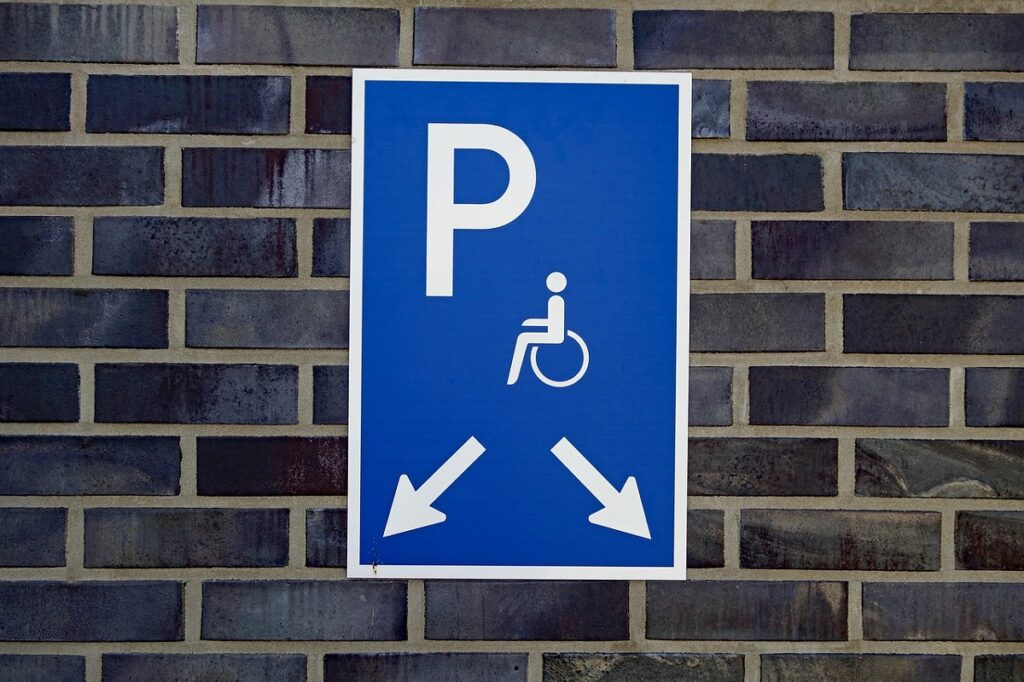Parking lots are often large and sprawling places, especially in suburban areas on the outskirts of cities. And even in inner-city parking lots, which typically have less room to sprawl horizontally, space is created by lots being several floors high. So it’s safe to say that in large parking lots, not all spaces are created equal, in terms of location and convenience.
Every parking lot in America is required by law to contain a certain number of disabled parking spaces. These spaces are reserved for handicap parking permit holders. They are provided to ensure that people with disabilities can have fair access to all amenities.
Many handicap parking permit holders have conditions that hamper their mobility, so the location of their parking space is especially important. But where is best for a disabled parking space to be located in a parking lot? What are the legal rules and regulations about disabled parking space placement within parking lots? Are all parking lots required to have the same number of disabled parking spaces? And what are disabled permit holders’ rights when it comes to parking in metered, on-street parking spaces?
Read on for the answers to these questions and more.
What Are Americans With Disabilities Act (ADA) Parking Spaces?
ADA parking spaces are spaces that adhere to the American With Disabilities Act rules and regulations. They are located in every parking lot in America as well as in on-street locations in neighborhoods and jurisdictions all over the country.
ADA parking spaces are marked by the International Symbol of Access and are reserved for disabled parking permit holders.
What Are ADA Handicapped Parking Rules And Regulations?
The ADA dictates that disabled parking spaces must:
- Be present in a certain number, depending on the size of the parking lot.
- Be present in increased numbers in certain types of medical facility parking lots.
- Connect to the shortest accessible route to the amenity they serve.
- Be eight feet wide for standard ADA spaces, and 11 feet wide for van-accessible ADA spaces.
- Have access aisles that are at least five feet wide.
- Be clearly marked by the International Symbol of Access.
Where Should Disabled Parking Spaces Be Located In A Parking Lot?
Under the ADA, disabled parking spaces must be located on the shortest route to an accessible entrance to the facility the parking lot serves, relative to other spaces in the same parking lot.
In parking lots where spaces serve more than one entrance to a facility, disabled parking spaces must be dispersed between all of the accessible entrances.
Why Is The Location Of A Disabled Parking Spot Important?
Disabled parking space location is very important because many disabled parking permit holders have mobility constraints. These constraints include things like an inability to walk for distances exceeding 200 feet, and an inability to walk at all without the aid of an assistive device. These permit holders need their parking spaces to be situated as close to an accessible entrance as possible.
The full list of disabled parking qualifying conditions varies slightly state by state, but it usually includes:
- An inability to walk without the use of an assistive device such as a brace, cane, crutch, prosthetic device, wheelchair or similar device
- An inability to walk 200 feet without needing to stop to rest
- Portable oxygen tank usage
- Lung disease
- Cardiac disease
- Loss or significant impairment of the use of one or both legs or both hands
- Arthritis
- Neurological disease

How Many Handicap Spots Are Required In A Parking Lot?
- Lots with 1 to 25 spaces – at least 1 disabled space.
- Lots with 26 to 50 spaces – at least 2 disabled spaces.
- Lots with 51 to 75 spaces – at least 3 disabled spaces.
- Lots with 76 to 100 spaces – at least 4 disabled spaces.
- Lots with 101 to 150 spaces – at least 5 disabled spaces.
- Lots with 151 to 200 spaces – at least 6 disabled spaces.
- Lots with 201 to 300 spaces – at least 7 disabled spaces.
- Lots with 301 to 400 spaces – at least 8 disabled spaces.
- Lots with 401 to 500 spaces – at least 9 disabled spaces.
- Lots with 501 to 1000 spaces – at least 2% of total spaces.
- Lots with 1001+ spaces – 20 disabled spaces + 1 for each 100 spaces over 1000.
How Many Disabled Parking Spaces Are Required In Hospital Parking Lots?
In hospitals, 10% of the total parking spaces must be designated as disabled spaces.
Rehabilitation and Outpatient Physical Therapy Facilities must have 20% of their total parking spaces designated as disabled spaces.
Can Disabled Permit Holders Park In Metered On-Street Spaces?
Some jurisdictions allow disabled parking permit holders to park in metered, on-street parking spaces for free and for an unlimited amount of time. Some jurisdictions insist that disabled drivers use metered, on-street spaces in the same way as non-permit holders. Often wheelchair-accessible parking meters are provided.
It is important to check with the disabled parking authorities in any jurisdiction you plan on visiting in order to find out their specific rules regarding metered, on-street spaces.
For more information on how to obtain a handicapped parking permit, contact Disabled Parking today.
Featured image by StephanieAlbert on Pixabay

